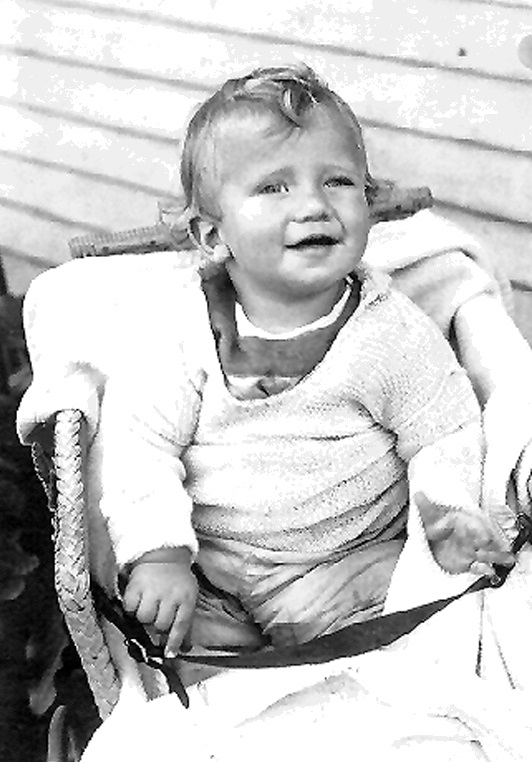
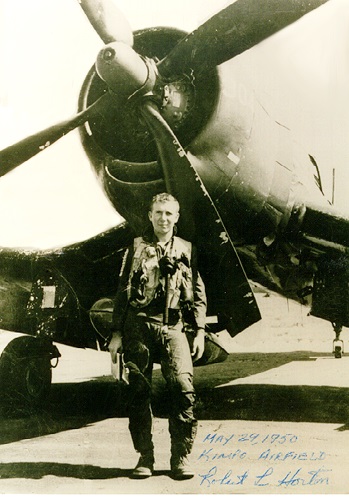
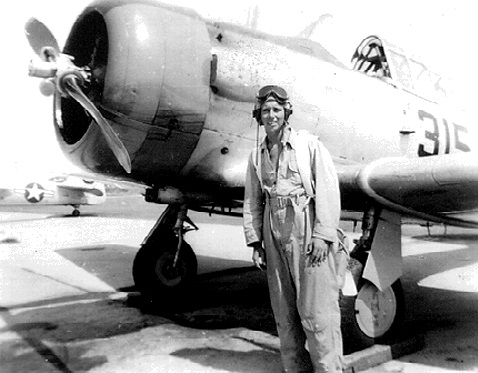
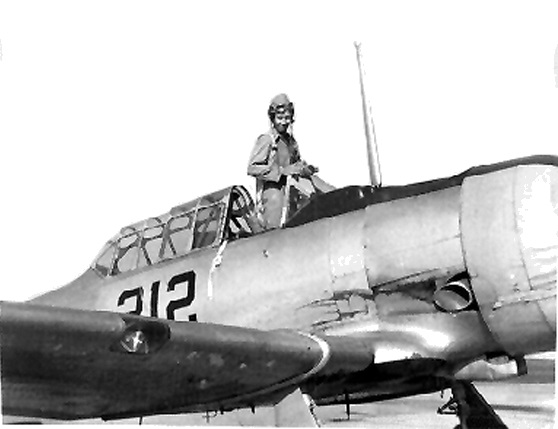
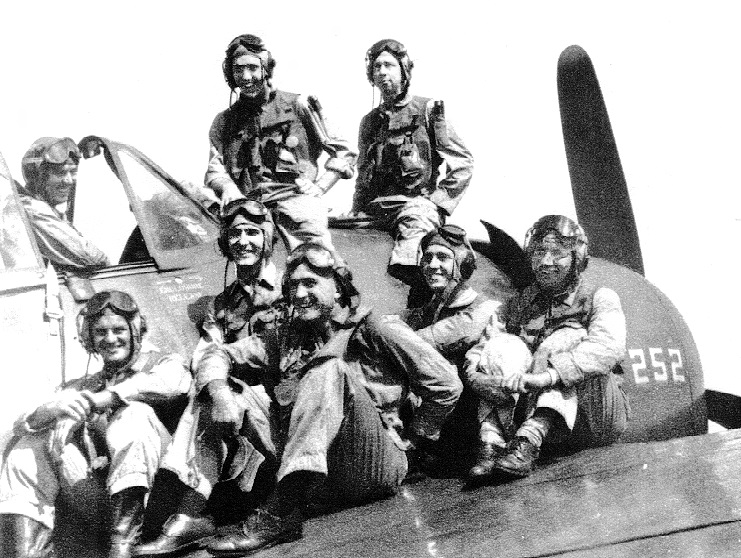
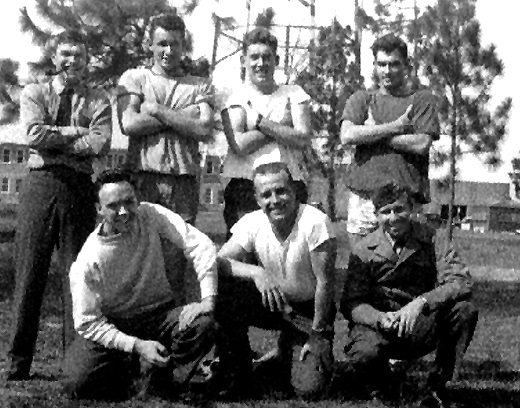
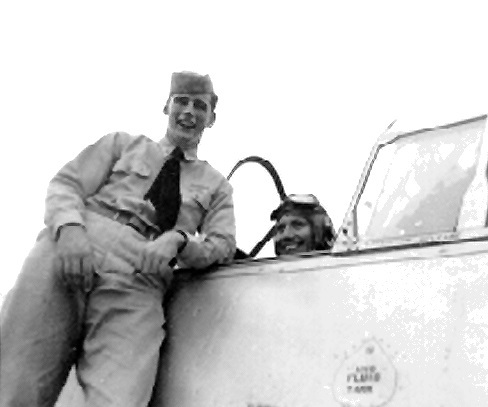
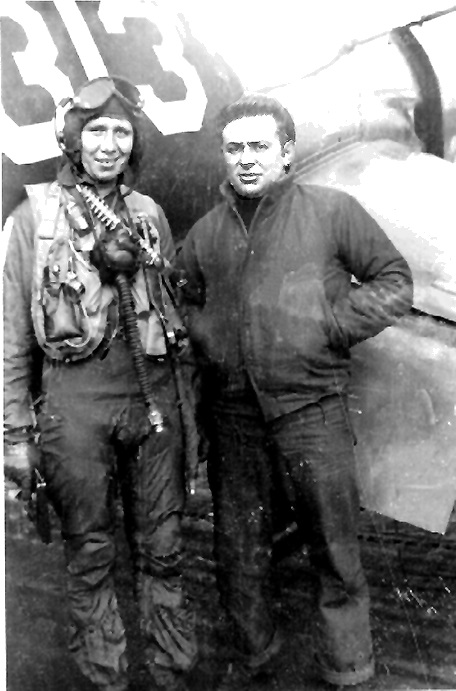
Our carrier, USS Philippine Sea (CV-47) with Carrier Air Group 11 and detachments on board joined with USS Valley Forge (CV-45), with Carrier Air Group 5 on board and commenced combat operations on August 5, 1950. Both air groups contained pilots who had been former Flying Midshipmen in the various squadrons. Our missions consisted of targets of opportunity in which many casualties were inflicted on North Korean ground troops. Many close air support missions were flown to provide relief and protection to our UN ground forces. There were few bridge strikes at this time because the Chinese forces had not entered the conflict yet. The major bridge strikes would come later. We attacked the Rising Sun oil refinery and anti-aircraft positions and the rail yards in Pyongyang and inflicted heavy damage in the area. A fun day would consist of catching an occasional steam locomotive in the open and punch it full of holes. Their favorite sanctuary would be a railroad tunnel which we would seal both ends with bombs. Our targets of opportunity consisted of strafing and napalming enemy troops who would hide in trees, houses, and in open areas. Railroads and shipping came under severe attack and we were quite successful in shutting down the north Korean surface transportation system.
After many strikes on the island of Wolmi Do in the Inchon Harbor area the invasion took place and the city of Seoul and Kimpo Airfield secured along with most of South Korea. Next came the march north to the Yalu River which proved very difficult and not without casualties suffered by our pilots. Our carrier forces intelligence suspected the Chinese had entered the conflict when one of our pilots reported seeing camels south of the Yalu River. At this point our UN Command Forces would begin a retreat south toward Hungnam and Wonsan Harbor area for evacuation and regrouping. At this time the bridge strikes became a top priority and were accomplished with great difficulty. Our bombing runs were made flying down the Yalu River with Manchuria to the north shooting at us as we made our runs and we couldn't return their fire. From this position the bridges presented an extremely small target and direct hits were made at great peril and difficulty. Once in awhile some stray twenty millimeter cannon and five inch HVAR rocket fire found their way "accidentally" into Manchuria.
Carrier Air Group was finally relieved of combat duty in March, 1951 and preparations were made to return to mainland USA on board USS Valley Forge. We were very happy after a job well done. Enclosed is a list of the lucky ex- Midshipmen of CAG eleven and the various squadrons they were in.
VF-11:
ENS E. [Elmer] M. Tollgaard [2-48],
ENS G. [Gene] A. Martin [3-48],
ENS J. E. Nicklin,
ENS H. H. Holloman,
ENS R. [Ronald] M. Gerdes [11-48].
VF-112:
ENS T. McGinnis,
ENS E. Jackson,
ENS F. [Fred] Pester [11-48],
ENS. D. Keefe,
ENS W. M. Stollenwerck [11-48],
ENS R. Aslund,
ENS D. Crow,
ENS A. [Allen] Hill [11-48].
VF-113:
ENS A. B. Forrest,
ENS S. Wallace,
ENS R. L. Horton [2-47],
ENS L. Olson,
ENS J. [Jack] Fairchild [21-47],
ENS J. [Jesse] McKnight [14-48],
ENS G. Farnworth,
ENS K. [Kenneth] A. Burrows [13-46],
ENS J. [Jerome] Hamill [13-47],
ENS R. Armstrong,
ENS Thornburg,
ENS Kembitskey,
ENS E. [Edward] Klapka.
VF-114:
ENS S. Kingery,
ENS C. Summitt,
ENS R. Hamre,
ENS S. Clauzel,
ENS R. Bernard.
VA-115:
ENS X. Villanueva,
ENS A. B. Price,
ENS L. Profilet.
Those killed or missing in action were:
ENS J. F. Kail,
ENS W. D. Noonan,
ENS C. L. Smith.
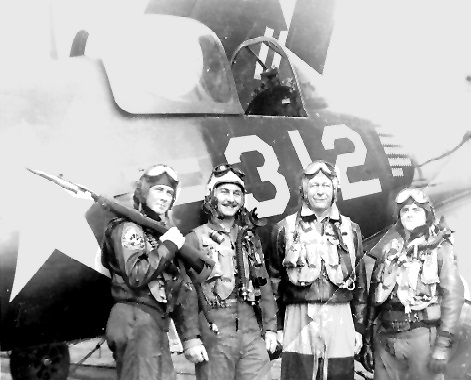
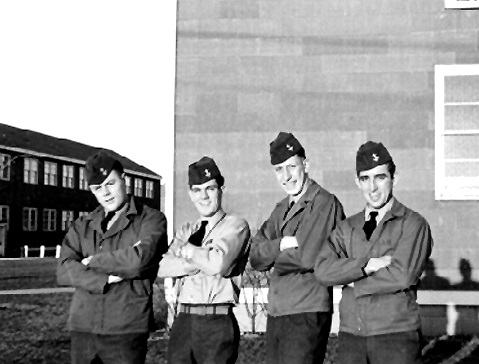
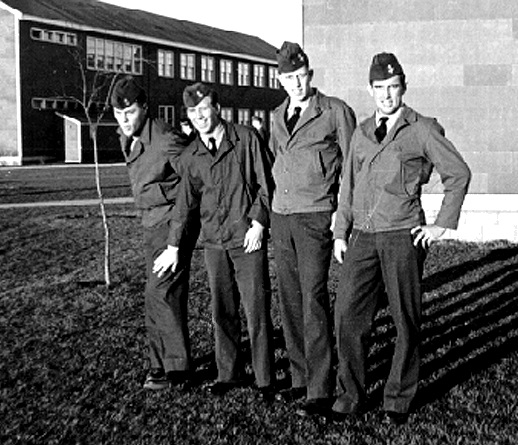
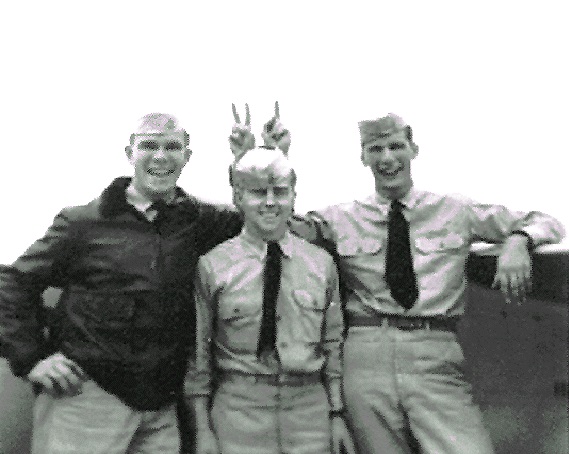
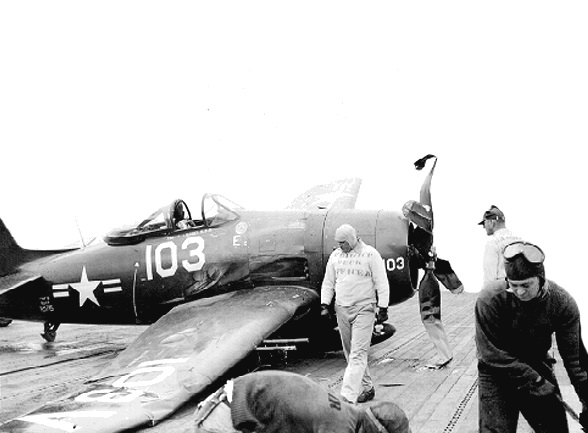
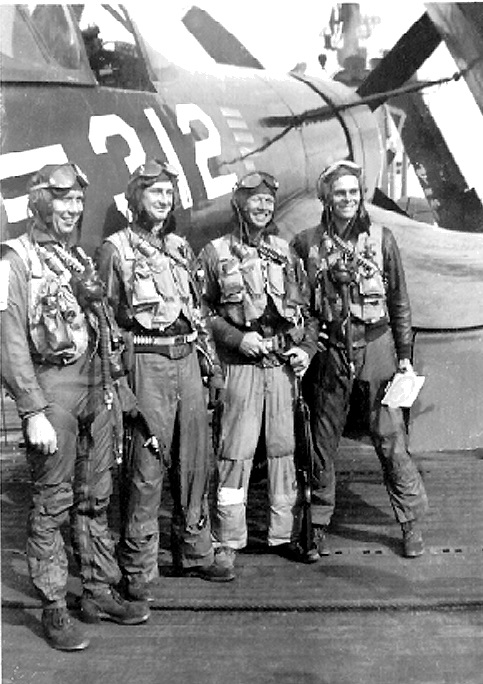
FLAT ON MY BACK AT TEN THOUSAND FEET!
November of 1950 wasn't considered my good month for aerial combat over North Korea. While going for the Yalu River Bridge the flak they threw at us was awesome to put it mildly. Besides ammo and rockets each F4U-4B had a five hundred [lb.] VT fused bomb for the AA batteries near the bridge. It was a maximum effort and all of the available aircraft of Air Group Eleven were involved. During our bombing run I felt a 'WOOMPH" and thought it was too close for comfort when my F4U rolled over on its back at 340 knots [as it took both hands on the stick to get my aircraft back upright]. By that time I was all by myself over the Yalu, throttle "two blocked" and all the AA batteries were shooting at me. What a lonely feeling. Visual inspection of my starboard wing showed a hole the size of a bathtub but I was still flying and kept ahead of the flak that was coming up at me. To my horror I realized the VT fused bomb was still with me. Why it didn't explode is beyond me. After I pickled the bomb on some hapless village I decided to test my aircraft to determine if I could safely land on my carrier. At ten thousand feet in slow flight with the gear and flaps down it was pretty stable. At faster speeds it wanted to roll over on its back. I managed to land on my carrier and the bird was fixed and ready to fly the next day.
I wasn't so lucky on 27 November though. While strafing some trucks in a valley I was hit by small arms fire. I was hit in the back just below my left shoulder blade. It felt as if I was hit by a baseball bat and my left arm began to go numb. The shrapnel severed my radio transmitter wire, bounced off my armor plate, and tore into me. I used the Morse Code taught me at good old Pre-Flight to tell the rest of the guys in my flight I was wounded and the XO and I started back to my carrier group which was steaming through a blizzard. After I received all the letters on the “ZB" I let down and broke out just above the water. After finding a slick in the ocean I followed it and all of a sudden there was the fantail of the USS Leyte. The strange thing was I was looking UP at the flight deck instead of DOWN! I had to climb my aircraft in order to land and it wasn't even my carrier but I couldn't be too choosy at that time. My aircraft had only one hole in it and was ready for the next mission as soon as the medics got me out and down to sick bay. I didn't fly another combat mission for almost two months after that. The shrapnel is still in my back and it only hurts me when I laugh real hard. Nothing much happened to me after that except getting my windshield shot out on another close air support mission. That one almost cost me my right ear. The rest of my flights over North Korea were ho-hummers.
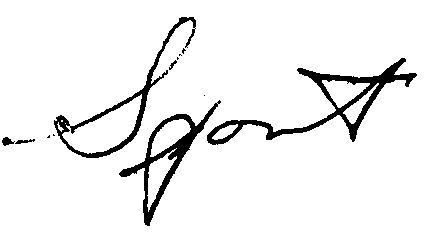
Christmas card to Lou and Elli Ives
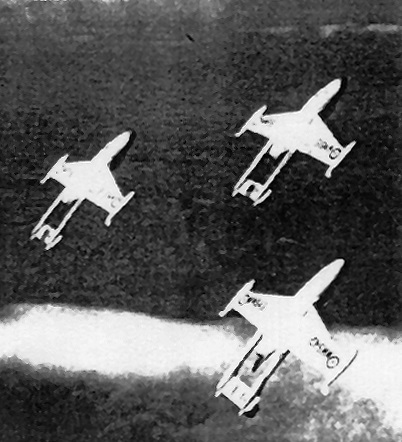 I believe those jets are Gloster Meteors [re: 1995 Christmas card from Lou and Elli – Bob "Smoe" Smyth's photograph]. I had one do a barrel roll around my "Connie" when flying over Switzerland many years ago.
I believe those jets are Gloster Meteors [re: 1995 Christmas card from Lou and Elli – Bob "Smoe" Smyth's photograph]. I had one do a barrel roll around my "Connie" when flying over Switzerland many years ago.
All the best for 1996
Judy and Bob Horton
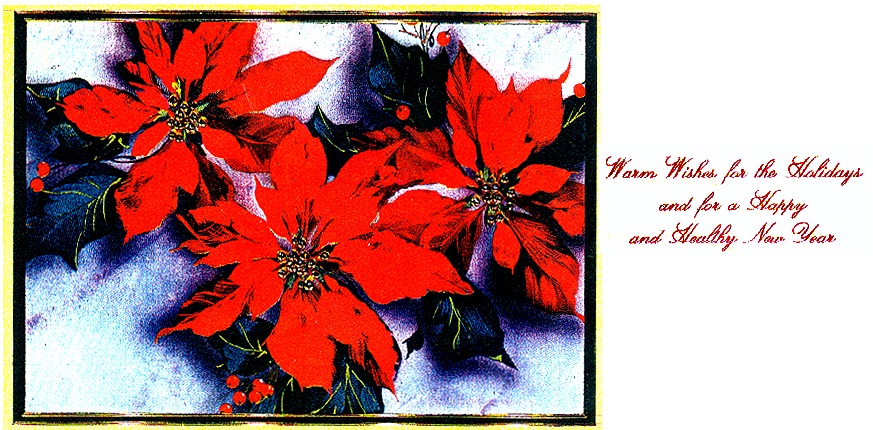
Letter to Pat Francis and Lou Ives
23 May 1998
As you requested, here is my account of a mission I flew to destroy a Yalu River bridge and anti-aircraft gun positions near Siuiju, North Korea 21 November, 1950.
It turned out to be a very bad day for me. In fact, the whole month of November turned out to be my Waterloo. On this day, our entire air group eleven was assigned a maximum effort mission to take out a bridge and anti-aircraft positions protecting it on the Yalu River.
On that particular day, my F4U Corsair was armed with the usual load of 20 mm cannon ammo, 5 inch HVAR rockets and a 500 lb VT fused bomb. Midway in the bombing run during fierce anti-aircraft fire which was plainly visible, I felt a bump and a whoomph and realized my aircraft had taken a direct hit in my starboard wing and suddenly I was experiencing inverted flight in my F4U. My immediate reaction was to throw my liberty hat over the side and then go out after it, but being a devout coward, I decided not to because I had been told that shore liberty wasn’t too good in that area during that particular time.
As my airspeed was around 340 knots, it took both hands on the stick to return my wounded aircraft back to somewhat normal flight. Why that 500 lb. bomb didn’t detonate and suddenly end my aspiring flying carrier permanently remains a mystery to me. Well it didn’t detonate and I had the throttle “two blocked” and I was flying up the Yalu River all by myself with everyone on the ground throwing everything they could up at me and I was still busy trying to keep my wounded bird flying right-side up. I suddenly realized I still had that 500 lb. bomb on board so I quickly dumped it hoping it would hit a nice juicy target on the ground, but I’ll never know.
Now came the time and problem of getting my wounded bird back to the carrier for a safe approach and landing. I wasn’t quite sure what this bird was going to do at slow speeds with the landing gear and flaps hanging out; so I decided to fly a simulated carrier approach at ten thousand feet which proved to be OK.
After assuring myself I could land safely, I cleaned up what was left of my aircraft and headed back to the carrier with my squadron skipper flying on my wing.
As I accelerated, the aircraft tended to start a roll to the right above 170 knots; so I settled on 160 knots airspeed. The approach and landing was a huge success as I caught the number three wire. Not bad for a young scared Naval Aviator with a flight suit full of you know what.
As I taxied up the flight deck, I folded the wings and waved at all the ghoulers on the ghouler’s bridge through the bathtub sized hole in my right wing.
Little did I know I would have a more serious problem before I had to make an emergency landing on the USS Leyte six days later after being wounded during a strafing attack and bombing run over North Korea.
By the way, my wounded corsair was flying the next day with a new right wing. Doesn’t time go real fast especially when you’re having fun?

P.S. I hope this little yarn satisfies your curiosity.
[Also printed in the winter 2001 Aviation Midshipmen LOG; © 2002.]
Another tale of the adventures of Robert L. "Sport" Horton during his many combat missions over Korea during the Korean "police action" of Carrier Air Group Eleven (VF-113) during the month of November, 1950.
As I stated in my previous adventure story the month of November, 1950 was not too pleasant for me and it almost cost me my life. This particular day my squadron division was assigned an armed recco mission covering an area just south of Sinuiju, North Korea and the weather that particular day was very cold and clear with good visibility. During our search I spotted three trucks in the area and I was told to lead the attack on these targets. Because it was very cold my 20mm cannons would not fire so I opted to drop some bombs on these trucks which were located in a small valley with hills on each side. After completing my run and during my pull up my F4U and I were hit by apparent ground fire and I took a hit in my upper left back near my shoulder blade just below my heart as I found out later. It felt as if someone hit me in the back with a baseball bat and I was propelled forward against my shoulder straps. Shortly afterward my left arm began to grow numb. I immediately radioed I had been hit and after finding I could not transmit but I could receive on my radio my division leader, LCDR Leo McCuddin suggested I should return to my aircraft carrier with him flying on my wing escorting me. During this time my left arm was becoming more numb to the point it was practically useless. My problems were becoming more serious as my carrier was in a heavy snowstorm. After arriving over my carrier group I began a descent on instruments and broke out less than 100 feet above the water. I made a left turn about 90 degrees and stayed on this compass heading until I saw a large slick on the water indicating a large ship had been there so I elected to follow this slick hoping I could find an aircraft carrier to land on and at this particular time I could care less about which one because I knew I needed immediate medical attention as I was beginning to feel rather weak at this time. All of a sudden the fantail of the carrier USS Leyte came into view and I flew by the starboard side looking up at the flight deck. My escort informed the carrier he had a wounded pilot that needed to come aboard and was given permission as they had the ready flight deck. As I made my approach to the carrier I suddenly realized this was the first time I had to climb in order to land aboard an aircraft carrier. As I entered the "groove" I broke a glass vial containing ammonia which kept me alert during the critical phase of my approach and landing which was successful. I was assisted out of my aircraft and escorted to sick bay where doctors attempted unsuccessfully to remove the bullet from my back. To this day it remains in me and only bothers me when there is a sudden change in temperature. At that time I guess I was the only Navy fighter pilot with a built-in radar blip. After approximately 51 days of medical recovery aboard ship I was returned to flight duty and resumed my combat flying with a renewed vengeance.
